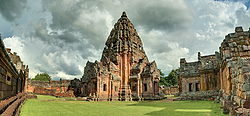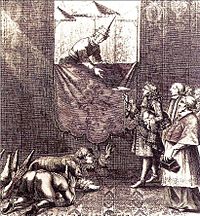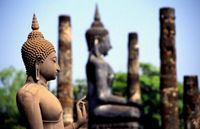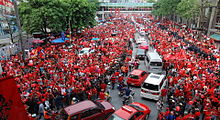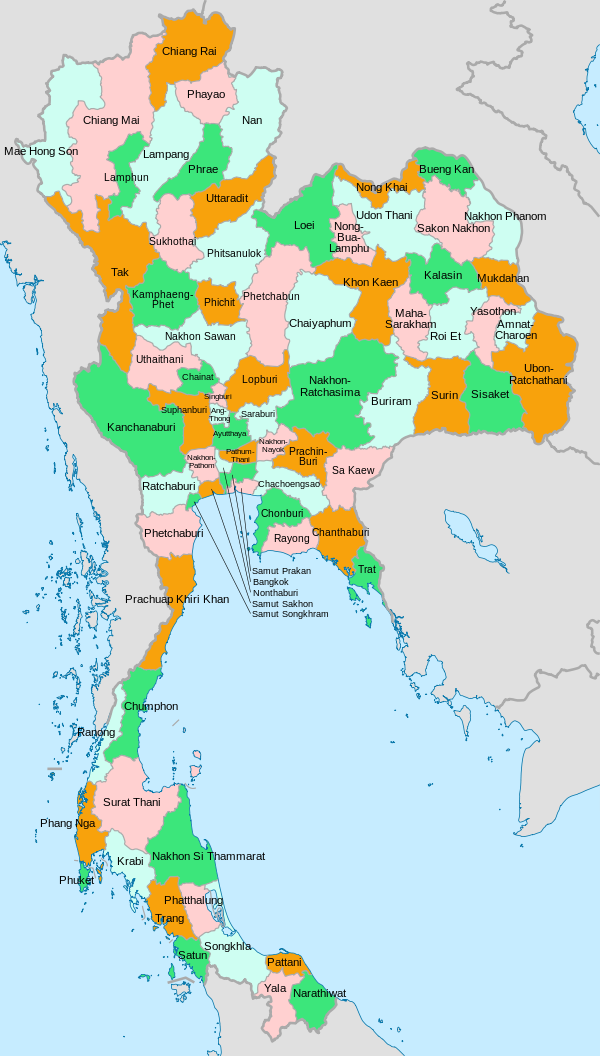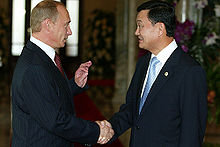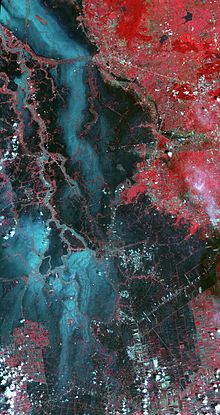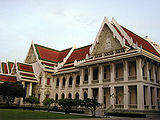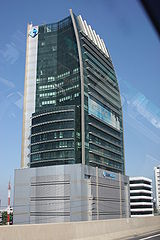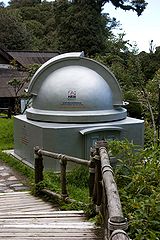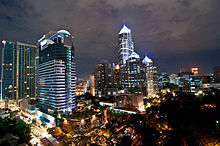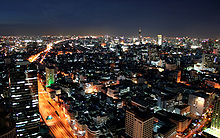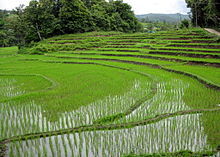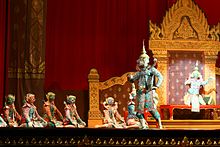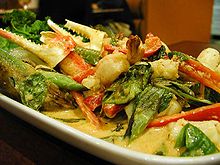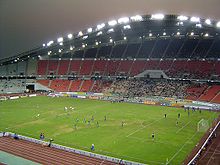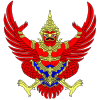- Thailand
-
Kingdom of Thailand ราชอาณาจักรไทย
Ratcha Anachak Thai
ประเทศไทย
Prathet Thai

Flag Emblem Anthem: Phleng Chat Thai
Royal anthem: Phleng Sansoen Phra BaramiLocation of Thailand (green)in ASEAN (dark grey) — [Legend]
Capital
(and largest city)Bangkok (Thai: Krung Thep)1
13°45′N 100°29′E / 13.75°N 100.483°EOfficial language(s) Thai[1] Official scripts Thai alphabet Demonym Thai Government Unitary parliamentary democracy and constitutional monarchy - King Bhumibol Adulyadej - Prime Minister Yingluck Shinawatra Legislature National Assembly - Upper House Senate - Lower House House of Representatives Formation - Sukhothai Kingdom 1238–1448 - Ayutthaya Kingdom 1351–1767 - Thonburi Kingdom 1768–1782 - Rattanakosin Kingdom 6 April 1782 - Constitutional monarchy 24 June 1932 - 2007 Constitution 24 August 2007 Area - Total 513,120 km2 (51st)
198,115 sq mi- Water (%) 0.4 (2,230 km2) Population - 2011 estimate 66,720,1532[2] (19th) - 2000 census 60,606,947[1] - Density 132.1/km2 (88th)
342/sq miGDP (PPP) 2010 estimate - Total $586.877 billion[3] (24th) - Per capita $9,187[3] (86th) GDP (nominal) 2010 estimate - Total $318.85 billion[3] (30th) - Per capita $4,992[3] (88th) Gini (2009) 42.5 [4] HDI (2011)  0.682[5] (medium) (103rd)
0.682[5] (medium) (103rd)Currency Baht (฿) ( THB)Time zone (UTC+7) Drives on the left ISO 3166 code TH Internet TLD .th, .ไทย Calling code +66 1 ^ Thai name: กรุงเทพมหานคร Krung Thep Maha Nakhon or Krung Thep. The full name is กรุงเทพมหานคร อมรรัตนโกสินทร์ มหินทรายุทธยา มหาดิลกภพ นพรัตนราชธานีบุรีรมย์ อุดมราชนิเวศน์มหาสถาน อมรพิมานอวตารสถิต สักกะทัตติยะวิษณุกรรมประสิทธิ์ Krung Thep Mahanakhon Amon Rattanakosin Mahinthara Yuthaya Mahadilok Phop Noppharat Ratchathani Burirom Udomratchaniwet Mahasathan Amon Phiman Awatan Sathit Sakkathattiya Witsanukam Prasit. 2 ^ According to the Department of Provincial Administration's official register, not taking into account unregistered citizens and immigrants. Thailand (
 /ˈtaɪlænd/ ty-land or /ˈtaɪlənd/[6]; Thai: ประเทศไทย, RTGS: Prathet Thai), officially the Kingdom of Thailand (Thai: ราชอาณาจักรไทย, RTGS: Ratcha Anachak Thai; IPA: [râːt.tɕʰā ʔāːnāːtɕàk tʰāj] (
/ˈtaɪlænd/ ty-land or /ˈtaɪlənd/[6]; Thai: ประเทศไทย, RTGS: Prathet Thai), officially the Kingdom of Thailand (Thai: ราชอาณาจักรไทย, RTGS: Ratcha Anachak Thai; IPA: [râːt.tɕʰā ʔāːnāːtɕàk tʰāj] ( listen)), formerly known as Siam (Thai: สยาม; RTGS: Sayam), is a country located at the centre of the Indochina peninsula and Southeast Asia. It is bordered to the north by Burma and Laos, to the east by Laos and Cambodia, to the south by the Gulf of Thailand and Malaysia, and to the west by the Andaman Sea and the southern extremity of Burma. Its maritime boundaries include Vietnam in the Gulf of Thailand to the southeast and Indonesia and India in the Andaman Sea to the southwest.
listen)), formerly known as Siam (Thai: สยาม; RTGS: Sayam), is a country located at the centre of the Indochina peninsula and Southeast Asia. It is bordered to the north by Burma and Laos, to the east by Laos and Cambodia, to the south by the Gulf of Thailand and Malaysia, and to the west by the Andaman Sea and the southern extremity of Burma. Its maritime boundaries include Vietnam in the Gulf of Thailand to the southeast and Indonesia and India in the Andaman Sea to the southwest.The country is a kingdom, with most recorded reigns in the world. It is a constitutional monarchy with King Rama IX, the ninth king of the House of Chakri, who has reigned since 1946, making him the world's longest-serving current head of state and the longest-reigning monarch in Thai history.[7] The king is officially titled Head of State, the Head of the Armed Forces, an Upholder of the Buddhist religion, and the Defender of all Faiths.
Thailand is the world's 51st largest country in terms of total area (slightly smaller than Yemen and slightly larger than Spain), with a surface area of approximately 513,000 km2 (198,000 sq mi), and the 21st most-populous country, with approximately 64 million people. The largest city is Bangkok, the capital, which is also the country's centre of political, commercial, industrial and cultural activities. About 75% of the population is ethnically Thai, 14% is of Chinese origin, and 3% is ethnically Malay;[1] the rest belong to minority groups including Mons, Khmers and various hill tribes. The country's official language is Thai. The primary religion is Buddhism, which is practiced by around 95% of all Thais.
Thailand experienced rapid economic growth between 1985 and 1995 and is a newly industrialized country with tourism, due to well-known tourist destinations such as Ayutthaya, Pattaya, Bangkok, Phuket, Krabi, Chiang Mai, and Ko Samui, and exports contributing significantly to the economy.[8][9] There are approximately 5.2 million legal and illegal migrants in Thailand.[10] Thailand has also attracted a number of expatriates from developed countries.[11]
Contents
Etymology
The country's official name was Siam (Thai: สยาม RTGS: Sayam, pronounced [sàjǎːm]) until June 23, 1939,[12] when it was changed to Thailand. It was then renamed Siam from 1945 to May 11, 1949, after which it was again renamed Thailand. Also spelled Siem, Syâm or Syâma, it has been identified with the Sanskrit Śyâma (श्याम, meaning "dark" or "brown"). The names Shan and A-hom seem to be variants of the same word, and Śyâma is possibly not its origin but a learned and artificial distortion.[13]
The word Thai (ไทย) is not, as commonly believed,[citation needed] derived from the word Tai (ไท) meaning "freedom" in the Thai language; it is, however, the name of an ethnic group from the central plains (the Thai people).[citation needed] A famous Thai scholar argued that Tai (ไท) simply means "people" or "human being" since his investigation shows that in some rural areas the word "Tai" was used instead of the usual Thai word "khon" (คน) for people.[14]
The Thai use the phrase "land of the free" to express pride in the fact that Thailand is the only country in Southeast Asia never colonized by a European power. While the Thai people will often refer to their country using the polite form Prathet Thai (Thai: ประเทศไทย), they most commonly use the more colloquial word Mueang Thai (Thai: เมืองไทย) or simply Thai (Thai: ไทย); the word mueang (Thai: เมือง) meaning nation but most commonly used to refer to a city or town. Ratcha Anachak Thai (Thai: ราชอาณาจักรไทย) means "Kingdom of Thailand" or "Kingdom of Thai".
Etymologically, its components are: -Ratcha- (from Sanskrit raja, meaning "king, royal, realm") ; -ana- (from Pāli āṇā, "authority, command, power", itself from Sanskrit ājñā, same meaning) -chak (from Sanskrit cakra or cakraṃ meaning "wheel", a symbol of power and rule). The Thai National Anthem (Thai: เพลงชาติ), composed and written by Peter Feit during the extremely "patriotic" 1930s, refers to the Thai nation as: prathet-thai (Thai: ประเทศไทย). The first line of the national anthem is: prathet thai ruam lueat nuea chat chuea thai (Thai: ประเทศไทยรวมเลือดเนื้อชาติเชื้อไทย) and was translated in 1939 by Colonel Luang Saranuprabhandi as: "Thailand is the unity of Thai blood and body."
History
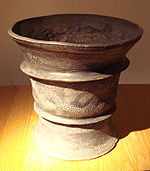 An example of pottery discovered near Ban Chiang in Udon Thani province, the earliest dating to 2100 BCE.
An example of pottery discovered near Ban Chiang in Udon Thani province, the earliest dating to 2100 BCE.
 The Ayutthaya period immense 19 meter high seated bronze Buddha in Wat Phanan Choeng from 1324 pre-dates the founding of the city in 1351
The Ayutthaya period immense 19 meter high seated bronze Buddha in Wat Phanan Choeng from 1324 pre-dates the founding of the city in 1351
The region known as Thailand has been inhabited by humans at least since the Paleolithic period, about 40,000 years ago. Similar to other regions in Southeast Asia, it was heavily influenced by the culture and religions of India, starting with the kingdom of Funan around the 1st century CE.
After the fall of the Khmer Empire in the 13th century, various states thrived there, such as the various Tai, Mon, Khmer and Malay kingdoms, as seen through the numerous archaeological sites and artifacts that are scattered throughout the Siamese landscape. Prior to the 12th century however, the first Thai or Siamese state is traditionally considered to be the Buddhist kingdom of Sukhothai, which was founded in 1238.
Following the decline and fall of the Khmer empire in the 13th–14th century, the Buddhist Tai kingdoms of Sukhothai, Lanna and Lan Xang (now Laos) were on the ascension. However, a century later, the power of Sukhothai was overshadowed by the new kingdom of Ayutthaya, established in the mid-14th century in the lower Chao Phraya River or Menam area.
Ayutthaya's expansion centred along the Menam while in the northern valley the Lanna Kingdom and other small Tai city-states ruled the area. In 1431, the Khmer abandoned Angkor after the Ayutthaya forces invaded the city.[15] Thailand retained a tradition of trade with its neighbouring states, from China to India, Persia and Arab lands. Ayutthaya became one of the most vibrant trading centres in Asia. European traders arrived in the 16th century, beginning with the Portuguese, followed by the French, Dutch and English.
After the fall of Ayutthaya in 1767 to the Burmese, King Taksin the Great moved the capital of Thailand to Thonburi for approximately 15 years. The current Rattanakosin era of Thai history began in 1782, following the establishment of Bangkok as capital of the Chakri dynasty under King Rama I the Great. According to Encyclopædia Britannica, "A quarter to a third of the population of some areas of Thailand and Burma were slaves in the 17th through the 19th centuries."[16][17]
Despite European pressure, Thailand is the only Southeast Asian nation that has never been colonized.[18] This has been ascribed to the long succession of able rulers in the past four centuries who exploited the rivalry and tension between French Indochina and the British Empire. As a result, the country remained a buffer state between parts of Southeast Asia that were colonized by the two colonizing powers, Great Britain and France. Western influence nevertheless led to many reforms in the 19th century and major concessions, most notably being the loss of a large territory on the east side of the Mekong to the French and the step-by-step absorption by Britain of the Malay Peninsula.
20th century
The losses initially included Penang and eventually culminated in the loss of four predominantly ethnic-Malay southern provinces, which later became Malaysia's four northern states, under the Anglo-Siamese Treaty of 1909.
In 1932, a bloodless revolution carried out by the Khana Ratsadon group of military and civilian officials resulted in a transition of power, when King Prajadhipok was forced to grant the people of Siam their first constitution, thereby ending centuries of absolute monarchy.
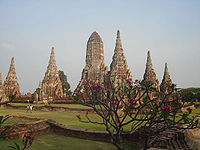 The ruins of Wat Chaiwatthanaram at Ayutthaya, the city was burned and sacked in 1767 by a Burmese army under the Alaungpaya Dynasty.
The ruins of Wat Chaiwatthanaram at Ayutthaya, the city was burned and sacked in 1767 by a Burmese army under the Alaungpaya Dynasty.
During World War II, the Empire of Japan demanded the right to move troops across Thailand to the Malayan frontier. Japan invaded the country and engaged the Thai Army for six to eight hours before Plaek Pibulsonggram ordered an armistice. Shortly thereafter Japan was granted free passage, and on December 21, 1941, Thailand and Japan signed a military alliance with a secret protocol wherein Tokyo agreed to help Thailand regain territories lost to the British and French. Subsequently, Thailand undertook to 'assist' Japan in its war against the Allies, while at the same time maintaining an active anti-Japanese resistance movement known as the Seri Thai. Approximately 200,000 Asian labourers (mainly romusha) and 60,000 Allied POWs worked on the Thailand–Burma Death Railway.[19]
After the war, Thailand emerged as an ally of the United States. As with many of the developing nations during the Cold War, Thailand then went through decades of political instability characterised by coups d'état as one military regime replaced another, but eventually progressed towards a stable prosperity and democracy in the 1980s.[citation needed]
The Southern region
Thailand controlled the Malay Peninsula as far as Malacca in the 1400s and held much of the peninsula for the next few centuries, including Tumasek (Singapore) some of the Andaman Islands and a colony on Java, but eventually failed when the British used force to guarantee their suzerainty over the sultanate.
All the states of the Malay Sultanate presented annual gifts to the Thai king in the form of a golden flower, which understood the gesture to be tribute and an acknowledgement of vassalage. The British intervened in the Malay State and with the Anglo-Siamese Treaty tried to build a railway from the south to Bangkok. Thailand relinquished sovereignty over what are now the northern Malay provinces of Kedah, Perlis, Kelantan and Terengganu to the British. Satun and Pattani provinces were given to Thailand. The Malay peninsula provinces were infiltrated by the Japanese during World War II, and by the Malayan Communist Party (CPM) from 1942 to 2008, when they decided to sue for peace with the Malaysian and Thai governments after the CPM lost its support from Vietnam and China subsequent to the Cultural Revolution. Recent insurgent uprisings may be a continuation of separatist fighting which started after World War II with Sukarno's support for the PULO, and the intensification. Most victims since the uprisings have been Buddhist and Muslim bystanders.
Politics and government
Main articles: Politics of Thailand, Constitutions of Thailand, Law of Thailand, Government of Thailand, and Foreign relations of ThailandThe politics of Thailand are currently conducted within the framework of a constitutional monarchy, whereby the Prime Minister is the head of government and a hereditary monarch is head of state. The judiciary is independent of the executive and the legislative branches.
History
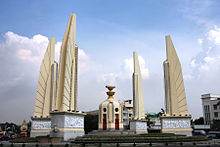 Bangkok's Democracy Monument: a representation of the 1932 Constitution sits on top of two golden offering bowls above a turret.
Bangkok's Democracy Monument: a representation of the 1932 Constitution sits on top of two golden offering bowls above a turret.
Since the political reform of the absolute monarchy in 1932, Thailand has had 17 constitutions and charters.[20][21] Throughout this time, the form of government has ranged from military dictatorship to electoral democracy, but all governments have acknowledged a hereditary monarch as the head of state.[22][23]
28 June 1932
Prior to 1932, the Kingdom of Siam did not possess a legislature, as all legislative powers were vested within the person of the monarch. This had been the case since the foundation of the Sukhothai Kingdom in the 12th century: as the king was seen as a "Dharmaraja" or "King who rules in accordance with Dharma" (the Buddhist law of righteousness). However on 24 June 1932 a group of civilians and military officers, calling themselves the Khana Ratsadon (or People's Party) carried out a bloodless revolution, in which the 150 years of absolute rule of the House of Chakri was ended. In its stead the group advocated a constitutional form of monarchy with an elected legislature.
The "Draft Constitution" of 1932 signed by King Prajadhipok, created Thailand's first legislature, a People's Assembly with 70 appointed members. The assembly met for the first time on 28 June 1932, in the Ananda Samakhom Throne Hall. The Khana Ratsadon decided that the people were not yet ready for an elected assembly; however they later changed their minds. By the time the "permanent" constitution came into force in December of that year, elections were scheduled for 15 November 1933. The new constitution also changed the composition of the assembly to 78 directly elected and 78 appointed (by the Khana Ratsadon) together compromising 156 members.
1933 to 1997
For events subsequent to the abdication of the king, including the name change of 1939, up to the coup d'état of 1957, see Plaek Pibulsonggram. For additional history to 1997, refer to his successors in the List of Prime Ministers of Thailand.
1997 to 2006
 Ananda Samakhom Throne Hall the old meeting place of the National Assembly, now only the State Opening is held there.
Ananda Samakhom Throne Hall the old meeting place of the National Assembly, now only the State Opening is held there.
The 1997 Constitution was the first constitution to be drafted by popularly elected Constitutional Drafting Assembly, and was popularly called the "People's Constitution".[24] The 1997 Constitution created a bicameral legislature consisting of a 500-seat House of Representatives (สภาผู้แทนราษฎร, sapha phutaen ratsadon) and a 200-seat Senate (วุฒิสภา, wuthisapha). For the first time in Thai history, both houses were directly elected.
Many human rights are explicitly acknowledged, and measures were established to increase the stability of elected governments. The House was elected by the first past the post system, where only one candidate with a simple majority could be elected in one constituency. The Senate was elected based on the province system, where one province can return more than one senator depending on its population size.
The two houses of the National Assembly have two different terms. In accordance with the constitution the Senate is elected to a six year term, while the House is elected to a four year term. Overall the term of the National Assembly is based on that of the House. The National Assembly each year will sit in two sessions an "ordinary session" and a "legislative session". The first session of the National Assembly must take place within thirty days after the general election of the House of Representatives. The first session must be opened by the king in person by reading a Speech from the Throne; this ceremony is held in the Ananda Samakhom Throne Hall. He may also appoint the crown prince or a representative to carry out this duty. It is also the duty of the king to prorogue sessions through a Royal Decree when the House term expires. The king also has the prerogative to call extraordinary sessions and prolong sessions at his discretion.
The National Assembly may host a "Joint-sitting" of both Houses under several circumstances. These include: The appointment of a regent, any alteration to the 1924 Palace Law of Succession, the opening of the first session, the announcement of policies by the Cabinet of Thailand, the approval of the declaration of war, the hearing of explanations and approval of a treaty and the amendment of the Constitution.
Members of the House of Representatives served four-year terms, while senators served six-year terms. The 1997 People's Constitution also promoted human rights more than any other constitutions. The court system (ศาล, saan) included a constitutional court with jurisdiction over the constitutionality of parliamentary acts, royal decrees, and political matters.
The January 2001 general election, the first election under the 1997 Constitution, was called the most open, corruption-free election in Thai history.[25] The subsequent government was the first in Thai history to complete a four-year term. The 2005 election had the highest voter turnout in Thai history.[26][27] Despite efforts to clean up the system, vote buying and electoral violence remained problems of electoral quality in 2005.[28]
The PollWatch Foundation, Thailand's most prominent election watchdog, declared that vote buying in this election, specifically in the North and the Northeast, was more serious than in the 2001 election. The organization also accused the government of violating the election law by abusing state power in presenting new projects in a bid to seek votes.
2006 coup d'état
Without meeting much resistance, a military junta overthrew the interim government of Thaksin Shinawatra on 19 September 2006. The junta abrogated the constitution, dissolved Parliament and the Constitutional Court, detained and later removed several members of the government, declared martial law, and appointed one of the king's Privy Counselors, General Surayud Chulanont, as the Prime Minister. The junta later wrote a highly abbreviated interim constitution and appointed a panel to draft a new permanent constitution. The junta also appointed a 250-member legislature, called by some critics a "chamber of generals" while others claimed that it lacks representatives from the poor majority.[29][30]
In this interim constitution draft, the head of the junta was allowed to remove the prime minister at any time. The legislature was not allowed to hold a vote of confidence against the cabinet and the public was not allowed to file comments on bills.[31] This interim constitution was later surpassed by the permanent constitution on 24 August 2007. Martial law was partially revoked in January 2007. The ban on political activities was lifted in July 2007,[32] following the 30 May dissolution of the Thai Rak Thai party. The new constitution was approved by referendum on 19 August, which led to a return to a democratic general election on 23 December 2007.
Political crisis
See also: 2008–2010 Thai political crisisThe People's Power Party (Thailand), led by Samak Sundaravej formed a government with five smaller parties. Following several court rulings against him in a variety of scandals, and surviving a vote of no confidence, and protesters blockading government buildings and airports, in September 2008, Sundaravej was found guilty of conflict of interest by the Constitutional Court of Thailand (due to being a host in a TV cooking program),[33] and thus, ended his term in office.
He was replaced by PPP member Somchai Wongsawat. As of October 2008, Wongsawat was unable to gain access to his offices, which were occupied by protesters from the People's Alliance for Democracy. On December 2, 2008, Thailand's Constitutional Court in a highly controversial ruling found the Peoples Power Party[34] guilty of electoral fraud, which led to the dissolution of the party according to the law. It was later alleged in media reports that at least one member of the judiciary had a telephone conversation with officials working for the Office of the Privy Council and one other. The phone call was taped and has since circulated on the Internet. In it, the callers discuss finding a way to ensure the ruling PPP party would be disbanded. Accusations of judicial interference were levelled in the media but the recorded call was dismissed as a hoax. However, in June 2010, supporters of the eventually disbanded PPP were charged with tapping a judge's phone.
Immediately following what many media described as a "judicial coup", a senior member of the Armed Forces met with factions of the governing coalition to get their members to join the opposition and the Democrat Party was able to form a government, a first for the party since 2001. The leader of the Democrat party, and former leader of the opposition, Abhisit Vejjajiva was appointed and sworn-in as the 27th Prime Minister, together with the new cabinet on 17 December 2008.
Thailand remains an active member of ASEAN (Association of South East Asian Nations).
In of April 2010, a set of new violent protests by the Red Shirt opposition movement resulted in 87 deaths (mostly civilian and some military) and 1,378 injured.[35] When the army tried to disperse the protesters on April 10, 2010, the army was met with automatic gunfire, grenades, and fire bombs from the opposition faction in the army, known as the "watermelon". This resulted in the army returning fire with rubber bullets and some live ammunition. During the time of the "red shirt" protests against the government, there have been numerous grenade and bomb attacks against government offices and the homes of government officials. Grenades were fired at protesters, that were protesting against the "red shirts" and for the government, by unknown gunmen killing one pro-government protester, the government stated that the Red Shirts protesters were firing the weapons at civilians.[36][37][38][39]
On 3 July 2011, the oppositional Pheu Thai Party led by Yingluck Shinawatra (the youngest sister of Thaksin Shinawatra) won the general election by a landslide (265 seats in the House of Representatives). They could form a coalition government presided over by Yingluck.
Administrative divisions
Main article: Subdivisions of ThailandThailand is divided into 76 provinces (จังหวัด, changwat), which are gathered into 5 groups of provinces by location. There are also 2 special governed districts: the capital Bangkok (Krung Thep Maha Nakhon) and Pattaya, of which Bangkok is at provincial level and thus often counted as a province.
Each province is divided into districts and the districts are further divided into sub-districts (tambons). As of 2006 there are 877 districts (อำเภอ, amphoe) and the 50 districts of Bangkok (เขต, khet). Some parts of the provinces bordering Bangkok are also referred to as Greater Bangkok (ปริมณฑล, pari monthon). These provinces include Nonthaburi, Pathum Thani, Samut Prakan, Nakhon Pathom and Samut Sakhon. The name of each province's capital city (เมือง, mueang) is the same as that of the province. For example, the capital of Chiang Mai province (Changwat Chiang Mai) is Mueang Chiang Mai or Chiang Mai.
A clickable map of Thailand exhibiting its provinces.Foreign relations
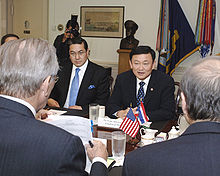 Thaksin Shinawatra and Surakiart Sathirathai meeting with former U.S. Defense Secretary Donald Rumsfeld on 19 September 2005
Thaksin Shinawatra and Surakiart Sathirathai meeting with former U.S. Defense Secretary Donald Rumsfeld on 19 September 2005
 Pimpen Vejjajiva, Michelle Obama, Prime Minister Abhisit Vejjajiva and U.S. President Barack Obama on 23 September 2009, in New York
Pimpen Vejjajiva, Michelle Obama, Prime Minister Abhisit Vejjajiva and U.S. President Barack Obama on 23 September 2009, in New York
The foreign relations of Thailand are handled by the Minister of Foreign Affairs of Thailand.
Thailand participates fully in international and regional organizations. It is a Major non-NATO ally and Priority Watch List Special 301 Report of the United States. Thailand has developed increasingly close ties with other ASEAN members—Indonesia, Malaysia, the Philippines, Singapore, Brunei, Laos, Cambodia, Burma, and Vietnam—whose foreign and economic ministers hold annual meetings. Regional cooperation is progressing in economic, trade, banking, political, and cultural matters. In 2003, Thailand served as APEC host. Dr. Supachai Panitchpakdi, the former Deputy Prime Minister of Thailand, currently serves as Secretary-General of the United Nations Conference on Trade and Development (UNCTAD). In 2005 Thailand attended the inaugural East Asia Summit.
In recent years, Thailand has taken an increasingly active role on the international stage. When East Timor gained independence from Indonesia, Thailand, for the first time in its history, contributed troops to the international peacekeeping effort. Its troops remain there today as part of a UN peacekeeping force. As part of its effort to increase international ties, Thailand has reached out to such regional organizations as the Organization of American States (OAS) and the Organization for Security and Cooperation in Europe (OSCE). Thailand has contributed troops to reconstruction efforts in Afghanistan and Iraq.
Thaksin initiated negotiations for several free trade agreements with China, Australia, Bahrain, India, and the US. The latter especially was criticized, with claims that high-cost Thai industries could be wiped out.[40]
Thailand joined the US-led invasion of Iraq, sending a 423-strong humanitarian contingent. It withdrew its troops on 10 September 2004. Two Thai soldiers died in Iraq in an insurgent attack.
Thaksin announced that Thailand would forsake foreign aid, and work with donor countries to assist in the development of neighbors in the Greater Mekong Sub-region.[41]
Thaksin was criticized for acting undiplomatically with foreign leaders and the international community and there were allegations of gaffes at international meetings.[42]
Thaksin was ambitious to position Thailand as a regional leader, initiating various development projects in poorer neighbouring countries like Laos. More controversially, he established close, friendly ties with the Burmese dictatorship, including extending the impoverished country a 4 billion baht credit line so it could conclude a satellite telecom deal with his family business.[43]
Thaksin energetically supported his former foreign minister Surakiart Sathirathai's somewhat improbable campaign to become UN Secretary General.
Abhisit appointed Peoples Alliance for Democracy leader Kasit Piromya as Foreign Minister. Prior to his appointment, Kasit had led anti-Cambodia protests and called Cambodian Prime Minister Hun Sen a "gangster minded (ใจนักเลง jai-nak-leng)" (he later claimed the word he used actually meant "a person who is lionhearted, a courageous and magnanimous gentleman"). In April 2009, "large-scale fighting" erupted between Thai and Cambodian troops amid the 900-year-old ruins of the Preah Vihear Hindu temple near the Cambodian border. The Cambodian government claimed its army had killed at least four Thais and captured 10 more, although the Thai government denied that any Thai soldiers were killed or injured. Two Cambodian soldiers were killed and three Thai soldiers were killed. Both armies blamed the other for firing first and denied entering the other's territory.[44][45]
Military
The Royal Thai Armed Forces (Thai: กองทัพไทย: Kongthap Thai) is the name of the military of the Kingdom of Thailand. It consists of the following branches:
- Royal Thai Army (กองทัพบกไทย)
- Royal Thai Navy (กองทัพเรือไทย, ราชนาวีไทย)
- Royal Thai Air Force (กองทัพอากาศไทย)
- Other Paramilitary Forces
Today the Royal Thai Armed Forces comprises about 1,025,640 personnel. The Head of the Thai Armed Forces (จอมทัพไทย: Chomthap Thai) is His Majesty King Bhumibol Adulyadej (Rama IX),[46] however this position is only nominal. The Armed Forces is managed by the Ministry of Defence of Thailand, which is headed by the Minister of Defence (a member of the Cabinet of Thailand) and commanded by the Royal Thai Armed Forces Headquarters, which in turn is headed by the Chief of Defence Forces of Thailand.[47]
According to the Constitution of the Kingdom, serving in the Armed Forces is a duty of all Thai citizens.[48] However only males over the age of 21, who have not gone through reserve training of the Army Reserve Force Students are given the option of whether they want to volunteer for the armed forces, or pick the random draft. The candidates are subjected to varying lengths of training from 6 months to 2 years of fulltime service depending on their education, whether they have partially completed the reserve training course, and whether they volunteered prior to the drafting date (usually April 1 every year).
Candidates with a recognized bachelor's degree will be subjected to 1 year of full-time service if they picked the random draft, or 6 months if they volunteer at their respective district office (Sasadee).
Likewise, the training length is also reduced for those who have partially completed the 3-year reserve training course (Ror Dor). A person who completed 1 year out of 3 will only have to serve full-time for 1 year. Those completed 2 years of reserve training will only have to do 6 months of full-time training. While those who complete 3 years or more of reserve training will be exempted.
The Royal Thai Armed Forces Day is celebrated on January 18 to commemorate the victory of King Naresuan the Great in battle against the Crown Prince of Burma in 1593.
Geography
Location

 Myanmar
Myanmar Myanmar
Myanmar
 Laos
Laos Laos
Laos
Andaman Sea
 Myanmar
Myanmar
 Laos
Laos
 Cambodia
Cambodia Thailand
Thailand 

Andaman Sea Gulf of Thailand
 Malaysia
MalaysiaGulf of Thailand Totaling 513,120 square kilometres (198,120 sq mi),[1] Thailand is the world's 50th largest country in land mass, while it is the world's 20th largest country in terms of population. It is comparable in population to countries such as France and the United Kingdom, and is similar in land size to France and California in the United States.
Thailand is home to several distinct geographic regions, partly corresponding to the provincial groups. The north of the country is mountainous, with the highest point being Doi Inthanon at 2,565 metres (8,415 ft) above sea level. The northeast, Isan, consists of the Khorat Plateau, bordered to the east by the Mekong River. The centre of the country is dominated by the predominantly flat Chao Phraya river valley, which runs into the Gulf of Thailand.
Southern Thailand consists of the narrow Kra Isthmus that widens into the Malay Peninsula. Politically, there are six geographical regions which differ from the others in population, basic resources, natural features, and level of social and economic development. The diversity of the regions is the most pronounced attribute of Thailand's physical setting.
The Chao Phraya and the Mekong River are the sustainable resource of rural Thailand. Industrial scale production of crops use both rivers and their tributaries. The Gulf of Thailand covers 320,000 square kilometres (124,000 sq mi) and is fed by the Chao Phraya, Mae Klong, Bang Pakong and Tapi Rivers. It contributes to the tourism sector owing to its clear shallow waters along the coasts in the Southern Region and the Kra Isthmus. The Gulf of Thailand is also an industrial centre of Thailand with the kingdom's main port in Sattahip along with being the entry gates for Bangkok's Inland Seaport.
The Andaman Sea is regarded as Thailand's most precious natural resource as it hosts the most popular and luxurious resorts in Asia. Phuket, Krabi, Ranong, Phang Nga and Trang and their lush islands all lay along the coasts of the Andaman Sea and despite the 2004 Tsunami, they continue to be and ever more so, the playground of the rich and elite of Asia and the world.
Plans have resurfaced of a logistical connection of the two bodies of water which would be coined the Thai Canal, analogous to the Suez and the Panama Canal. Such an idea has been greeted with positive accounts by Thai politicians as it would cut fees charged by the Ports of Singapore, improve ties with China and India, lower shipping times and increase ship safety owing to pirate fears in the Strait of Melaka and, support the Thai government's policy of being the logistical hub for Southeast Asia.
The ports would improve economic conditions in the south of Thailand, which relies heavily on tourism income, and it would also change the structure of the Thai economy moving it closer to a services centre of Asia. The canal would be a major engineering project and has expected costs of 20–30 billion dollars.
Climate
The local climate is tropical and characterized by monsoons. There is a rainy, warm, and cloudy southwest monsoon from mid-May to September, as well as a dry, cool northeast monsoon from November to mid-March. The southern isthmus is always hot and humid.
Education
Thailand enjoys a high level of literacy, and education is provided by a well-organized school system of kindergartens, primary, lower secondary and upper secondary schools, numerous vocational colleges, and universities. The private sector of education is well developed and significantly contributes to the overall provision of education which the government would not be able to meet through the public establishments. Education is compulsory up to and including age group 14, and the government provides free education through to age group 17.
Thailand has never been colonized, and its teaching relies heavily on rote rather than on student-centred methodology. Education in a modern sense is therefore relatively recent and still needs to overcome some major cultural hurdles to ensure further development and improvement to its standards.
The establishment of reliable and coherent curricula for its primary and secondary schools is subject to such rapid changes that schools and their teachers are not always sure what they are supposed to be teaching, and authors and publishers of textbooks are unable to write and print new editions quickly enough to keep up with the volatile situation.
The issue concerning university entrance has therefore also been in constant upheaval for a number of years. Nevertheless, education has seen its greatest progress in the years since 2001. Most of the present generation of students are computer literate, and knowledge of English is on the increase at least in quantity if not in quality.
Extensive nationwide IQ tests were carried out in December 2010 to January 2011 on 72,780 Thai students. The average IQ was found to be at 98.59, which is higher than previous studies have found. The IQ levels are not consistent throughout the country though, with the lowest average of 88.07 found in the southern region of Narathiwat and the highest average of 108.91 reported in Nonthaburi province. The Thai Ministry of Public Health blames the discrepancies on iodine deficiency and steps are being taken to require that iodine be added to table salt, a practice common in many Western countries.[49]
Science and technology
Main article: Science and technology in ThailandThe National Science and Technology Development Agency is an agency of the government of Thailand which supports research in science and technology and their application in the Thai economy.
From the agency's website:
The National Science and Technology Development Agency (NSTDA) reflects the Thai government's deep commitment to apply scientific and technological capabilities to promote and sustain the nation's economic, social development and growth through the promotion of linkage and collaboration between the public and private sectors. Since its inception in 1991, NSTDA has grown into an active organization with a diverse program focusing on cutting-edge S&T research, design, development and engineering. NSTDA offers a full potential and opportunity for cooperative challenges and investment. Through such a convergence, the organization brings a layered, multi-faceted approach to the scholarly and most practical description of scientific and technological discoveries and advancement to serve national needs and maintain a sustained linkage with the international community.
The Synchrotron Light Research Institute (SLRI) is a Thai research institution on physics, chemistry, material science and life sciences. It is located on the Suranaree University of Technology Campus (SUT), in Nakhorn Ratchaseema, about 300 km north east of Bangkok. The Institute, financed by the Ministry of Science and Technology (MOST), houses the only large scale synchrotron in South East Asia. It was originally built as the SORTEC synchrotron in Japan and later moved to Thailand and modified for 1.2 GeV operation. It provides users with regularly scheduled light.
Economy
Thailand is an emerging economy and considered as a newly industrialized country. After enjoying the world's highest growth rate from 1985 to 1996 – averaging 12.4% annually – increased pressure on Thailand's currency, the baht, in 1997, the year in which the economy contracted by 1.9% led to a crisis that uncovered financial sector weaknesses and forced the Chavalit Yongchaiyudh administration to float the currency, however, Prime Minister Chavalit Yongchaiyudh was forced to resign after his cabinet came under fire for its slow response to the crisis. The baht was pegged at 25 to the US dollar from 1978 to 1997, however, the baht reached its lowest point of 56 to the US dollar in January 1998 and the economy contracted by 10.8% that year. This collapse prompted the Asian financial crisis.
Thailand's economy started to recover in 1999, expanding 4.2% and 4.4% in 2000, thanks largely to strong exports. Growth (2.2%) was dampened by the softening of the global economy in 2001, but picked up in the subsequent years owing to strong growth in Asia, a relatively weak baht encouraging exports and increasing domestic spending as a result of several mega projects and incentives of Prime Minister Thaksin Shinawatra, known as Thaksinomics. Growth in 2002, 2003 and 2004 was 5–7% annually. Growth in 2005, 2006 and 2007 hovered around 4–5%. Due both to the weakening of the US dollar and an increasingly strong Thai currency, by March 2008, the dollar was hovering around the 33 baht mark.
Thailand exports an increasing value of over $105 billion worth of goods and services annually.[1] Major exports include Thai rice, textiles and footwear, fishery products, rubber, jewellery, cars, computers and electrical appliances. Thailand is the world's no.1 exporter of rice, exporting more than 6.5 million tons of milled rice annually. Rice is the most important crop in the country. Thailand has the highest percentage of arable land, 27.25%, of any nation in the Greater Mekong Subregion.[50] About 55% of the arable land area is used for rice production.[51]
Substantial industries include electric appliances, components, computer parts and cars, while tourism in Thailand makes up about 6% of the economy. Prostitution in Thailand and sex tourism also form a de facto part of the economy. Cultural milieu combined with poverty and the lure of money have caused prostitution and sex tourism in particular to flourish in Thailand. One estimate published in 2003 placed the trade at US$4.3 billion per year or about three percent of the Thai economy.[52] According to research by Chulalongkorn University on the Thai illegal economy, prostitution in Thailand in the period between 1993 and 1995, made up around 2.7% of the GDP.[53] It is believed that at least 10% of tourist dollars are spent on the sex trade.[54]
The economy of Thailand is an emerging economy which is heavily export-dependent, with exports accounting for more than two thirds of gross domestic product (GDP) The exchange rate is Baht 33.00/USD.
Thailand has a GDP worth 8.5 trillion Baht (on a purchasing power parity (PPP) basis), or US$627 billion (PPP). This classifies Thailand as the 2nd largest economy in Southeast Asia after Indonesia. Despite this, Thailand ranks midway in the wealth spread in Southeast Asia as it is the 4th richest nation according to GDP per capita, after Singapore, Brunei and Malaysia.
It functions as an anchor economy for the neighboring developing economies of Laos, Burma, and Cambodia. Thailand's recovery from the 1997–1998 Asian financial crisis depended mainly on exports, among various other factors. Thailand ranks high among the world's automotive export industries along with manufacturing of electronic goods.
Between 1997 and 2010, 4'306 mergers & acquisitions with a total known value of USD$81 billion with the involvement of Thai firms have been announced.[55] The year 2010 was a new record in terms of value with USD$12 billion of transactions. The largest transaction with involvement of Thai companies has been: PTT Chemical PCL merged with PTT Aromatics and Refining PCL valued at USD$3.8 billion in 2011.[56]
49% of Thailand's labor force is employed in agriculture, however this is less than the 70% employed in 1980.[57] Agriculture has been experiencing a transition from labour intensive and transitional methods into a more industrialised and competitive sector.[57] Between 1962 and 1983, the agricultural sector grew by 4.1% on average a year and continued to grow at 2.2% between 1983 and 2007.[57] However, the relative contribution of agriculture to GDP has declined while exports of goods and services have increased.
Tourism revenues are on the rise. With the instability surrounding the recent coup and the military rule, however, the GDP growth of Thailand has settled at around 4–5% from previous highs of 5–7% under the previous civilian administration, as investor and consumer confidence has been degraded somewhat due to political uncertainty.
The incumbent elected civilian administration under Samak Sundaravej in power from January 29 to September 9, 2008 stated that the economy will have grown by 5.5% to 6% by the end of 2008. Due to rising oil and food prices, the annual inflation rate for 2008 shot up to 9.2% in July; a 10-year high.
Thailand generally uses the metric system but traditional units of measurement for land area are used, and imperial measure (feet, inches etc.) are occasionally used with building materials such as wood and plumbing sizes. Years are numbered as B.E. (Buddhist Era) in education, the civil service, government, and on contracts and newspaper datelines; in banking, however, and increasingly in industry and commerce, standard Western year (Christian or Common Era) counting prevails.[58]
Demographics
City Name Province Pop. Rank City Name Province Pop. 
Bangkok
Nonthaburi
Nonthaburi1 Bangkok Krung Thep Maha Nakhon 9,801,394 11 Chiang Mai Chiang Mai 106,654 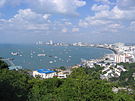
Pattaya
2 Nonthaburi Nonthaburi 3,760,320 12 Nakhon Sawan Nakhon Sawan 90,412 3 Pattaya Chonburi 958,824 13 Ubon Ratchathani Ubon Ratchathani 84,509 4 Hat Yai Songkhla 176,742 14 Nakhon Pathom Nakhon Pathom 83,007 5 Nakhon Ratchasima Nakhon Ratchasima 166,217 15 Phitsanulok Phitsanulok 79,535 6 Pak Kret Nonthaburi 156,342 16 Phuket Phuket 74,218 7 Udon Thani Udon Thani 138,332 17 Songkhla Songkhla 73,170 8 Surat Thani Surat Thani 127,753 18 Chiang Rai Chiang Rai 67,176 9 Khon Kaen Khon Kaen 113,754 19 Laem Chabang Chonburi 64,607 10 Nakhon Si Thammarat Nakhon Si Thammarat 109,353 20 Yala Yala 62,896 Language
Historical populations Year Pop. ±% 1910 8,131,247 — 1919 9,207,355 +13.2% 1929 11,506,207 +25.0% 1937 14,464,105 +25.7% 1947 17,442,689 +20.6% 1960 26,257,916 +50.5% 1970 34,397,371 +31.0% 1980 44,824,540 +30.3% 1990 54,548,530 +21.7% 2000 60,916,441 +11.7% 2010 65,479,453 +7.5% Source: [3] National Statistical Office of Thailand The official language of Thailand is Thai, a Tai–Kadai language closely related to Lao, Shan in Burma, and numerous smaller languages spoken in an arc from Hainan and Yunnan south to the Chinese border. It is the principal language of education and government and spoken throughout the country. The standard is based on the dialect of the central Thai people, and it is written in the Thai alphabet, an abugida script that evolved from the Khmer script. Several other dialects exist, and coincide with the regional designations. Southern Thai is spoken in the southern provinces, and Northern Thai is spoken in the provinces that were formally part of the independent kingdom of Lannathai.
Thailand is also host to several other minority languages, the largest of which is the Lao dialect of Isan spoken in the northeastern provinces. Although sometimes considered a Thai dialect, it is a Lao dialect, and the region in where it is traditionally spoken was historically part of the Lao kingdom of Lan Xang. In the far south, Yawi, a dialect of Malay, is the primary language of the Malay Muslims. Varieties of Chinese are also spoken by the large Chinese population, with Teochew being best represented.
Numerous tribal languages are also spoken, including those belonging to the Mon–Khmer family, such as Mon, Khmer, Viet, Mlabri; Austronesian family, such as Cham, Moken, and Orang Asli, Sino-Tibetan family such as Lawa, Akhan, and Karen; and other Tai languages such as Nyaw, Phu Thai, and Saek. Hmong is a member of the Hmong–Mien languages, which is now regarded as a language family of its own.
English is a mandatory school subject, but the number of fluent speakers remains very low, especially outside the cities.
Religion
The national religion is Theravada Buddhism. Thai Buddhism ranks amongst the highest in the world. According to the last census (2000) 94.6% of the total population are Buddhists of the Theravada tradition. Muslims are the second largest religious group in Thailand at 4.6%.[1][59] Thailand's southernmost provinces – Pattani, Yala, Narathiwat and part of Songkhla Chumphon have dominant Muslim populations, consisting of both ethnic Thai and Malay. The southern tip of Thailand is mostly ethnically Malay, and most Malays are Sunni Muslims. Christians represent 0.7% of the population. A small but influential community of Sikhs in Thailand and some Hindus also live in the country's cities, and are heavily engaged in retail commerce. There is also a small Jewish community in Thailand, dating back to the 17th century.
Culture
Thai culture has been shaped by many influences, including Indian, Lao, Burmese, Cambodian, and Chinese.
Its traditions incorporate a great deal of influence from India, China, Cambodia, and the rest of Southeast Asia. Thailand's national religion Theravada Buddhism is important to modern Thai identity. Thai Buddhism has evolved over time to include many regional beliefs originating from Hinduism, animism as well as ancestor worship. The official calendar in Thailand is based on the Eastern version of the Buddhist Era, which is 543 years ahead of the Gregorian (western) calendar. For example, the year AD 2011 is 2554 BE in Thailand.
Several different ethnic groups, many of which are marginalized, populate Thailand. Some of these groups overlap into Burma, Laos, Cambodia, and Malaysia and have mediated change between their traditional local culture, national Thai and global cultural influences. Overseas Chinese also form a significant part of Thai society, particularly in and around Bangkok. Their successful integration into Thai society has allowed for this group to hold positions of economic and political power.

Life in ThailandCuisine
Culture
Dance
Instruments
Demographics
Economy
Education
Film
Holidays
Languages
Literature
Media
Monarchy
Music
Politics
Religion
Society
Sport
Tourismedit box The traditional Thai greeting, the wai, is generally offered first by the younger of the two people meeting, with their hands pressed together, fingertips pointing upwards as the head is bowed to touch their face to the hands, usually coinciding with the spoken word "Sawasdee khrap" for male speakers, and "Sawasdee ka" for females. The elder then is to respond afterwards in the same way. Social status and position, such as in government, will also have an influence on who performs the wai first. For example, although one may be considerably older than a provincial governor, when meeting it is usually the visitor who pays respect first. When children leave to go to school, they are taught to wai to their parents to represent their respect for them. They do the same when they come back. The wai is a sign of respect and reverence for another, similar to the namaste greeting of India and Nepal.
Muay Thai, or Thai boxing, is the national sport in Thailand and its native martial art call "Muay". In the past "Muay" was taught to royal soldiers for combat on battlefield if unarmed. After they retired from the army, these soldiers often became Buddhist monks and stayed at the temples. Most of the Thai people's lives are closely tied to Buddhism and temples; they often send their sons to be educated with the monks. "Muay" is also one of the subjects taught in the temples.[60] Muay Thai achieved popularity all over the world in the 1990s. Although similar martial arts styles exist in other Southeast Asian countries, few enjoy the recognition that Muay Thai has received with its full-contact rules allowing strikes including elbows, throws and knees.
Association football, however, has possibly overtaken Muay Thai's position as most widely viewed and liked sport in contemporary Thai society and it is not uncommon to see Thais cheering their favourite English Premier League teams on television and walking around in replica kits. Another widely enjoyed pastime, and once a competitive sport, is kite flying.
Thai cuisine blends five fundamental tastes: sweet, spicy, sour, bitter and salty. Some common ingredients used in Thai cuisine include garlic, chillies, lime juice, lemon grass, and fish sauce. The staple food in Thailand is rice, particularly jasmine variety rice (also known as Hom Mali rice) which is included in almost every meal. Thailand is the world's largest exporter of rice, and Thais domestically consume over 100 kg of milled rice per person per year.[51] Over 5000 varieties of rice from Thailand are preserved in the rice gene bank of the International Rice Research Institute (IRRI), based in the Philippines. The king of Thailand is the official patron of IRRI.[61]
Like most Asian cultures, respect towards ancestors is an essential part of Thai spiritual practice. Thais have a strong sense of hospitality and generosity, but also a strong sense of social hierarchy. Seniority is an important concept in Thai culture. Elders have by tradition ruled in family decisions or ceremonies. Older siblings have duties to younger ones.
Taboos in Thailand include touching someone's head or pointing with the feet, as the head is considered the most sacred and the foot the dirtiest part of the body.Thai society has been influenced in recent years by its widely available multi-language press and media. There are some English and numerous Thai and Chinese newspapers in circulation; most Thai popular magazines use English headlines as a chic glamor factor. Many large businesses in Bangkok operate in English as well as other languages.
Thailand is the largest newspaper market in Southeast Asia with an estimated circulation of at least 13 million copies daily in 2003. Even upcountry, out of Bangkok, media flourishes. For example, according to Thailand's Public Relations Department Media Directory 2003–2004, the nineteen provinces of Isan, Thailand's northeastern region, hosted 116 newspapers along with radio, TV and cable.
Birth in Thailand
Main article: Birth in ThailandSports
Thai boxing
Muay Thai (Thai: มวยไทย, RTGS: Muai Thai, [muɛj tʰɑj], lit. "Thai Boxing") is a form of hard martial art practiced in large parts of the world, including Thailand and other Southeast Asian countries. The art is similar to others in Southeast Asia such as: Pradal Serey in Cambodia, Lethwei in Burma, Tomoi in Malaysia, and Muay Lao in Laos. Muay Thai has a long history in Thailand and is the country's national sport.
Pone Kingpetch was a Thai boxer, from Hua Hin, who defeated Pascal Perez, an Argentinean boxer to become the first Thai WBC Flyweight Champion on 16 April 1960 and later a 3 time WBC Flyweight Champion. Pone Kingpetch originally known as Mana Sidokbuab, assumed this name from his training camp; Kingpetch. Thai fighters traditionally take on the name of the camps they train for. That owner of the gym and head coach's, Thongtos Intratat is present in these pictures. Thongtos Intratat is also known for being the first person to officially formulate and bottle Namman Muay (Thai Liniment) which is desired for his fighter, Pone Kingpetch. Namman Muay (Thai Liniment) is still only produced by his direct descendants in Thailand.
Traditional Muay Thai practiced today varies significantly from the ancient art Muay Boran and uses kicks, punches and knee and elbow strikes in a ring with gloves similar to those used in Western boxing and this has led to Thailand gaining medals at the Olympic Games in Boxing.
Sepak Takraw
Takraw (Thai: ตะกร้อ) is a sport native to Thailand, which the players hit a rattan ball and only be allowed to use their feet, knees, chest and head to touch the ball. Sepak Takraw is a form of this sport which appears in volley ball style, the players must volley a ball over a net and force it to hit the ground on oppnent's side. It is a popular in other countries in Southeast Asia also. A rather similar game but played only with the feet is Buka ball.
Rugby
Rugby is also a growing sport in Thailand with the Thailand national rugby union team rising to be ranked 61st in the world.[62] Thailand became the first country in the world to host an international 80 kg welterweight rugby tournament in 2005.[63] The national domestic Thailand Rugby Union (TRU) competition includes several universities and services teams such as Chulalongkorn University, Mahasarakham University, Kasetsart University, Prince of Songkla University, Thammasat University, Rangsit University, the Thai Police, the Thai Army, the Thai Navy and the Royal Thai Air Force. Local sports clubs which also compete in the TRU include the British Club of Bangkok, the Southerners Sports Club (Bangkok) and the Royal Bangkok Sports Club.
Golf
Thailand has been called the Golf Capital of Asia[64] as it is a popular destination for golf. The country attracts a large number of golfers from Japan, Korea, Singapore, South Africa and Western countries who come to play golf in Thailand every year.[65] The growing popularity of golf, especially among the middle classes and expats, is evident since there are more than 200 world-class golf courses nationwide,[66] and some of them are chosen to host PGA and LPGA tournaments, such as Amata Spring Country Club, Alpine Golf & Sports Club, Thai Country Club and Black Mountain Golf Club.
Football
Thammasat Stadium is a multi-purpose stadium in Bangkok, Thailand. It is currently used mostly for football matches. The stadium holds 25,000. It is located in Thammasat University's Rangsit campus.
It was built for the 1998 Asian Games by construction firm Christiani and Nielsen, the same company that constructed the Democracy Monument in Bangkok.
Its appearance is that of a scaled down version of the Rajamangala Stadium. The tribunes form a continuous ring which are quite low behind each goal but rise up on each side. Unlike the Rajamangala though, Thammasat has a roof covering both side tribunes. Most striking about this stadium are the floodlights. Thai architects usually favour concrete pylons but these are the steel variety. As viewed from the exterior of the stadium the base of each pylon seems to grip the outside of the stadium and they dramatically lean over the tribunes so as to better illuminate the playing area.
Thammasat was going to be used for PEA FC's match against Singapore Armed Forces FC in an Asian Champions League qualifier in February 2009 but the pitch was deemed unplayable and the match was switched to the Rajamangala.
Rajamangala National Stadium is the biggest sporting arena in Thailand. It currently has a capacity of 65,000. It is located in Bang Kapi, Bangkok. The stadium was built in 1998 for the 1998 Asian Games and is the home stadium of Thailand national football team up to present.
Rugby union
Main article: Rugby union in ThailandOther sports Other sports in Thailand are slowly growing as the country develops its sporting infrastructure. The success in sports like weightlifting and Taekwondo at the last two Summer Olympic Games has demonstrated that boxing is no longer the only medal chance for Thailand.
International rankings
Organization Survey Ranking Heritage Foundation Indices of Economic Freedom 50 out of 157 A.T. Kearney/Foreign Policy Magazine Global Services Location Index 2009 4 out of 50 Reporters Without Borders Worldwide Press Freedom Index 134 out of 169 Transparency International Corruption Perceptions Index 84 out of 179 United Nations Development Programme Human Development Index 78 out of 177 World Economic Forum Global Competitiveness Report(2008) 34 out of 134[67] World Gold Council Gold reserve(2010) 33 out of 110 See also
- Outline of Thailand
- Index of Thailand-related articles
- Royal Thai Police
- Telecommunications in Thailand
- Thai ceramics
- Thai temple art and architecture
- Tourism in Thailand
- Transportation in Thailand
References
- ^ a b c d e f g CIA World Factbook Thailand, CIA World Factbook.
- ^ ประกาศสานักทะเบียนกลาง กรมการปกครอง เรื่อง จานวนราษฎรทั่วราชอาณาจักร แยกเป็นกรุงเทพมหานครและจังหวัดต่าง ๆ ตามหลักฐานการทะเบียนราษฎร ณ วันที่ 31 ธันวาคม 2553
- ^ a b c d "Report for Thailand". World Economic Outlook Database. International Monetary Fund. http://www.imf.org/external/pubs/ft/weo/2011/01/weodata/weorept.aspx?pr.x=61&pr.y=20&sy=2010&ey=2015&scsm=1&ssd=1&sort=country&ds=.&br=1&c=578&s=NGDPD%2CNGDPDPC%2CPPPGDP%2CPPPPC&grp=0&a=. Retrieved 2011-07-25.
- ^ "Human Development Report". UNDP. 2009. http://hdrstats.undp.org/en/indicators/161.html. Retrieved 2011-10-27.
- ^ "Human Development Report 2011 – Human development statistical annex". HDRO (Human Development Report Office United Nations Development Programme. pp. 127–130. http://hdr.undp.org/en/media/HDR_2011_EN_Tables.pdf. Retrieved 2 November 2011.
- ^ "Merriam-Webster Online". Merriam-webster.com. 2007-04-25. http://www.merriam-webster.com/dictionary/thailand. Retrieved 2010-04-25.
- ^ "A Royal Occasion speeches". Worldhop.com Journal. 1996. http://www.worldhop.com/Journals/J5/ROYAL.HTM. Retrieved 2006-07-05.
- ^ Thailand and the World Bank, World Bank on Thailand country overview.
- ^ The Guardian, Country profile: Thailand, 25 April 2009.
- ^ THAILAND: Burmese migrant children missing out on education. IRIN Asia. June 15, 2009.
- ^ Hard lessons in expat paradise. BBC News. December 14, 2006.
- ^ Thailand (Siam) History, CSMngt-Thai.
- ^ Eliot, Charles (1921). The Project Gutenberg EBook of Hinduism and Buddhism, An Historical Sketch, Vol. 3 (of 3) [EBook #16847]. London: Routledge & Kegan Paul Ltd.. pp. Ch. xxxvii 1; citing in turn Footnote 189: The name is found on Champan inscriptions of 1050 A.D. and according to Gerini appears in Ptolemy's Samarade = Sâmaraṭṭha. See Gerini, Ptolemy, p. 170. But Samarade is located near Bangkok and there can hardly have been Tais there in Ptolemy's time; and Footnote 190: So too in Central Asia Kustana appears to be a learned distortion of the name Khotan, made to give it a meaning in Sanskrit..
- ^ จิตร ภูมิศักดิ์ 1976: "ความเป็นมาของคำสยาม ไทย ลาวและขอม และลักษณะทางสังคม ของชื่อชนชาติ" (Jid Phumisak 1976: "Coming Into Existence for the Siamese Words for Thai, Laotian and Khmer and Societal Characteristics for Nation-names")
- ^ "Science news: What happened at Angkor Wat". The Washington Post. April 13, 2010.
- ^ Slave-owning societies. Encyclopædia Britannica.
- ^ Slavery in Nineteenth-Century Northern Thailand. Kyoto Review of South East Asia.
- ^ "King, country and the coup". Indian Express. September 22, 2006. http://www.indianexpress.com/news/king-country-and-the-coup/13140/0. Retrieved 2011-11-03.
- ^ Werner Gruhl, Imperial Japan's World War Two, 1931–1945, Transaction Publishers, 2007 ISBN 978-0-7658-0352-8
- ^ The Council of State, Constitutions of Thailand. This list contains 2 errors: it states that the 6th constitution was promulgated in 1912 (rather than 1952), and it states that the 11th constitution was promulgated in 1976 (rather than 1974).
- ^ Thanet Aphornsuvan, The Search for Order: Constitutions and Human Rights in Thai Political HistoryPDF (152 KB), 2001 Symposium: Constitutions and Human Rights in a Global Age: An Asia Pacific perspective
- ^ "A list of previous coups in Thailand". Associated Press. September 19, 2006. http://www.ctv.ca/servlet/ArticleNews/story/CTVNews/20060919/thailand_coups_060919/20060919/. Retrieved 2010-04-25.
- ^ "A list of recent coups in Thailand's history". Foxnews.com. 2006-09-19. http://www.foxnews.com/story/0,2933,214562,00.html. Retrieved 2010-04-25.
- ^ Kittipong Kittayarak, The Thai Constitution of 1997 and its Implication on Criminal Justice ReformPDF (221 KB)
- ^ Robert B. Albritton and Thawilwadee Bureekul, Developing Democracy under a New Constitution in ThailandPDF (319 KB), National Taiwan University and Academia Sinica Asian Barometer Project Office Working Paper Series No. 28, 2004
- ^ Pongsudhirak Thitinan, "Victory places Thaksin at crossroads", Bangkok Post, 9 February 2005
- ^ "Unprecedented 72% turnout for latest poll". The Nation. 10 February 2005. http://www.nationmultimedia.com/Election2005/news/news.php?news=02%2F10020506.htm.
- ^ Aurel Croissant and Daniel J. Pojar, Jr., Quo Vadis Thailand? Thai Politics after the 2005 Parliamentary Election, Strategic Insights, Volume IV, Issue 6 (June 2005)
- ^ The Nation, NLA 'doesn't represent' all of the people, 14 October 2006
- ^ The Nation, Assembly will not play a major role, 14 October 2006
- ^ The Nation, Interim charter draft, 27 September 2006
- ^ "Ban on political activities lifted". The Nation. 18 July 2007. http://www.nationmultimedia.com/2007/07/18/politics/politics_30041398.php.
- ^ Ahuja, Ambika (10 September 2008). "Thai Premier Ousted Over Stints on Cooking Show". washingtonpost.com. http://www.washingtonpost.com/wp-dyn/content/article/2008/09/09/AR2008090900505.html. Retrieved 2010-04-25.
- ^ Thailändisches Verfassungsgericht verbietet Regierungspartei. Spiegel, December 2, 2008
- ^ "PM vows to seek truth". Bangkok Post. 22 May 2010. http://bangkokpost.com/news/politics/178754/pm-vows-to-seek-truth. Retrieved 22 May 2010.
- ^ BBC News, Bangkok clashes death toll climbs to 18, with 800 hurt, 11 April 2010
- ^ Aj Jazeera English, Bloodiest Thai clashes in 18 years, 11 April 2010
- ^ NST Online Australia, Australia 'very concerned' over Thailand clashes, 11 April 2010
- ^ Bangkok Post, [1], 15 April 2010
- ^ "FTA Watch Group website". Ftawatch.org. http://www.ftawatch.org/. Retrieved 2010-04-25.
- ^ "Thaksin's Chance for Leading Role in the Region". Straits Times. 10 March 2004. http://yaleglobal.yale.edu/display.article?id=3502.
- ^ "Ex-envoys tell of 'multi-tasking' premier". The Nation. 17 March 2006. http://nationmultimedia.com/2006/03/26/headlines/headlines_30000240.php.
- ^ 'Thaksin to face charges over Burma telecom deal. ICT News, 2 August 2007
- ^ The Telegraph, Troops from Thailand and Cambodia fight on border, 3 April 2009
- ^ Bloomberg, Thai, Cambodian Border Fighting Stops, Thailand Says, 3 April 2009
- ^ Chapter 2 of the 2007 Constitution of Thailand
- ^ John Pike (2005-04-27). "www.globalsecurity.org". www.globalsecurity.org. http://www.globalsecurity.org/military/world/thailand/mod.htm. Retrieved 2010-04-25.
- ^ Chapter 4 of the 2007Constitution of Thailand
- ^ "MOPH reports low IQ among Thai youth : National News Bureau of Thailand". Thainews.prd.go.th. 2011-07-08. http://thainews.prd.go.th/en/news.php?id=255407070017. Retrieved 2011-11-03.
- ^ "CIA world factbook – Greater Mekong Subregion". Cia.gov. https://www.cia.gov/library/publications/the-world-factbook/fields/2097.html. Retrieved 2011-11-03.
- ^ a b "Rice Around The World. Thailand". Irri.org. http://web.archive.org/web/20080327095326/http://www.irri.org/science/cnyinfo/thailand.asp. Retrieved 2010-04-25.
- ^ Thailand mulls legal prostitution. The Age, November 26, 2003
- ^ Pasuk Phongpaichit Thailand's illegal economy and public policy. Seminar paper delivered at the Centre of Southeast Asian Studies, Kyoto University, November 1999
- ^ Paradise revealed, Taipei Times. 25 January 2006
- ^ "Statistics on Mergers & Acquisitions (M&A) – M&A Courses | Company Valuation Courses | Mergers & Acquisitions Courses". Imaa-institute.org. http://www.imaa-institute.org/statistics-mergers-acquisitions.html#MergersAcquisitions_Thailand. Retrieved 2011-11-03.
- ^ "PTT Chemical, PTT Aromatics Boards Approve Merger Plan". Businessweek. 2011-02-24. http://www.businessweek.com/news/2011-02-24/ptt-chemical-ptt-aromatics-boards-approve-merger-plan.html. Retrieved 2011-11-03.
- ^ a b c Henri Leturque and Steve Wiggins 2010. Thailand's progress in agriculture: Transition and sustained productivity growth. London: Overseas Development Institute
- ^ "Weights and measures in Thailand". Cockatoo.com. 1923-12-17. http://www.cockatoo.com/english/thailand/thailand-weights-measures.htm. Retrieved 2010-04-25.
- ^ "U.S. Department of States – Thailand". State.gov. http://www.state.gov/g/drl/rls/irf/2006/71359.htm. Retrieved 2010-04-25.
- ^ Muay Thai History[dead link]
- ^ Cooperation of IRRI and ThailandPDF (38.7 KB)
- ^ "International Rugby Board – THAILAND". Irb.com. http://www.irb.com/unions/union=11000019/index.html. Retrieved 2010-04-25.
- ^ The Nation, [2], 19 July 2005
- ^ "Golf in Thailand by". Golfasia.com. http://www.golfasia.com/golfthailand.php. Retrieved 2010-04-25.
- ^ Chawadee Nualkhair. "Thailand woos foreign golfers with sun, sand traps". Reuters. http://www.reuters.com/article/lifestyleMolt/idUSTRE56913I20090710. Retrieved 2010-04-25.
- ^ "Why to book with golf2thailand.com : Thailand Golf Courses Thailand Golf Packages". Golf2thailand.com. http://www.golf2thailand.com/golf_course_thailand.asp. Retrieved 2010-04-25.
- ^ "Global Competitiveness Report 2008-2009" (PDF). World Economic Forum. www.weforum.org. 2008. http://www.weforum.org/pdf/gcr/2008/rankings.pdf. Retrieved 2008-09-12.
External links
- Government
- Thaigov.go.th Royal Government of Thailand
- Thai National Assembly Official Thai Parliament website
- Chief of State and Cabinet Members
- Mfa.go.th Thailand Ministry of Foreign Affairs
- Thailand Internet Information National Electronics and Computer Technology Center
- Ministry of Culture
- General information
- Thailand entry at The World Factbook
- Thailand entry in Library of Congress Country Studies. 1987
- Thailand from UCB Libraries GovPubs
- Thailand at the Open Directory Project
- Wikimedia Atlas of Thailand
- Longdo Map On-line Thailand maps in English and Thai
- Thailand Laws – Thailand acts and legal information, both in English and Thai language.
- Travel
- Tourism Authority of Thailand Official tourism website
- Thailand travel guide from Wikitravel
- Other
- Flickr: Photos tagged with "Thailand"
- Thailand Country Fact Sheet from the Common Language Project
- Southeast Asia Visions. "Browse the Southeast Asia Visions Collection". Cornell University Library. http://dlxs.library.cornell.edu/s/sea/browse_image/date/1900.php. Retrieved October 2, 2011. "Browse by image date"
Links to related articles Geographic locale Countries and other territories in Southeast Asia Sovereign states Dependent territories - Christmas Island, Australia
- Cocos (Keeling) Islands, Australia
Subdivisions - Andaman and Nicobar Islands, India
- Hainan, PRC
- Paracel Islands, PRC
- Pratas Islands, ROC
- Spratly Islands
- (Taiping Island, ROC)
Countries and territories bordering the Indian Ocean Africa Comoros · Djibouti · Egypt · Eritrea · France (Mayotte and Réunion) · Kenya · Madagascar · Mauritius · Mozambique · Rodrigues, Mauritius · Seychelles · Somalia · Somaliland (Unrecognized) · South Africa · Sudan · Tanzania · Zanzibar, TanzaniaAsia Bahrain · Bangladesh · British Indian Ocean Territory (Chagos Archipelago), United Kingdom · Burma · Christmas Island and Cocos (Keeling) Islands, Australia · India · Indonesia · Iran · Iraq · Israel · Jordan · Kuwait · Malaysia · Maldives · Oman · Pakistan · Qatar · Saudi Arabia · Sri Lanka · Thailand · Timor-Leste · United Arab Emirates · YemenOther International membership Association of Southeast Asian Nations Governance Member states Enlargement Summits/Forums - ASEAN Summits
- ASEAN +3
- AMU
- ASEAN Regional Forum
- ASEM
- East Asia Summit
- CEPEA
- CMI
Related articles - Anthem
- Common Time
- Date of Establishment
- Emblem
- Flag
- Hymn
- Organizations
- SEA Games
- Secretariat
- Treaty of Amity and Cooperation
East Asia Summit (EAS) - First
- Second
- Third
- Fourth
- Fifth
- Sixth
Asia-Pacific Economic Cooperation (APEC) Meetings Monarchies List of current sovereign monarchs · List of current constituent monarchsBy continent By country Antigua and Barbuda · Australia · Andorra · The Bahamas · Bahrain · Barbados · Belize · Belgium · Bhutan · Brunei · Cambodia · Canada · Denmark · Grenada · Jamaica · Japan · Jordan · Kuwait · Liechtenstein · Lesotho · Luxembourg · Malaysia · Monaco · Morocco · Netherlands · New Zealand · Norway · Oman · Papua New Guinea · Qatar · Spain · Saint Kitts and Nevis · Saint Lucia · Saint Vincent and the Grenadines · Saudi Arabia · Solomon Islands · Swaziland · Sweden · Thailand · Tonga · Tuvalu · United Arab Emirates · United Kingdom · Vatican CityBy type Italics indicate Commonwealth realms, which each share the same person as head of state.Categories:- Thailand
- Southeast Asian countries
- Countries of the Indian Ocean
- Countries bordering the South China Sea
- Constitutional monarchies
- Member states of the Association of Southeast Asian Nations
- Member states of the United Nations
Wikimedia Foundation. 2010.

![Location of Thailand (green)in ASEAN (dark grey) — [Legend]](/pictures/enwiki/50/250px-Location_Thailand_ASEAN.svg.png)
